Firing Stock Photos and Images
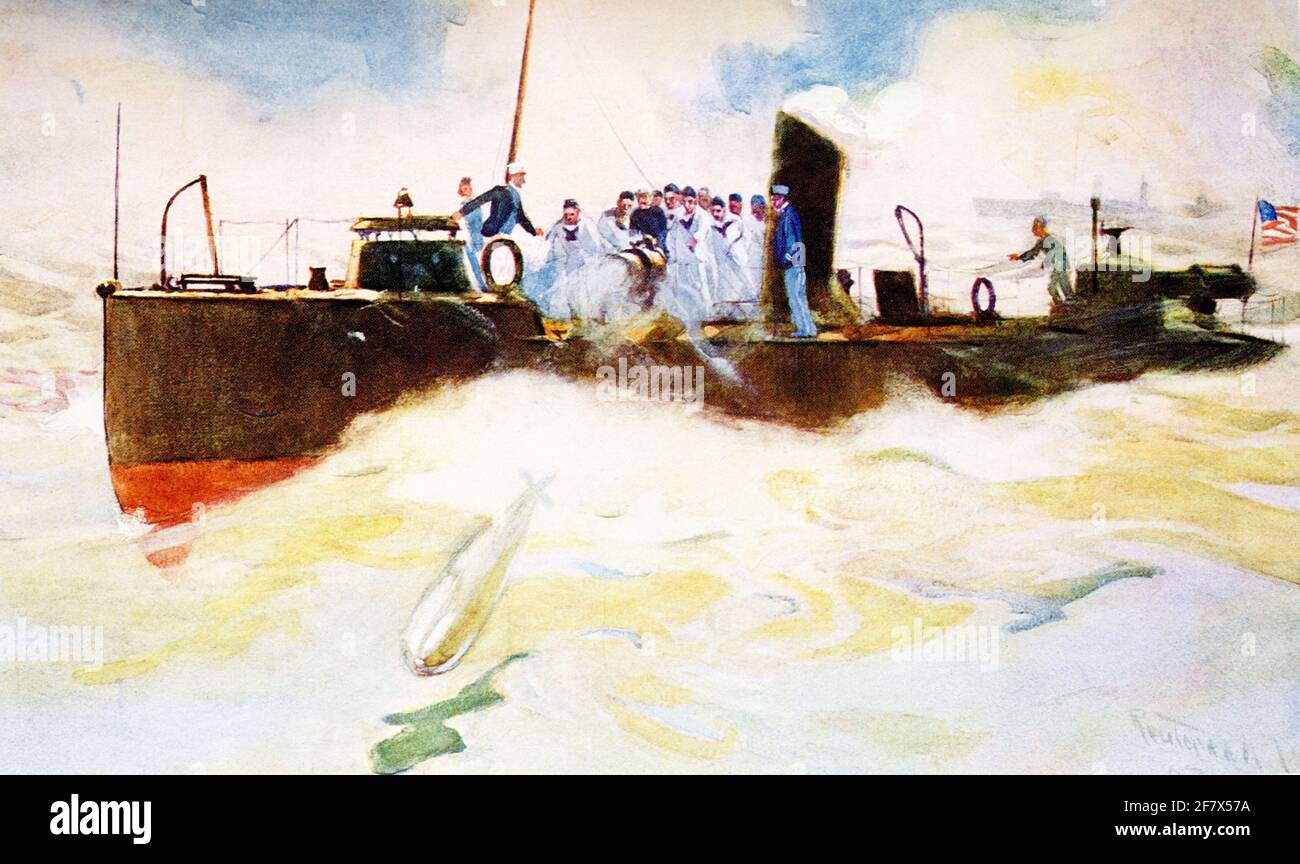 Naval cadets at practice firing a torpedo - so reads the caption. It was drawn by Henry Reuterdahl (1870-1925), a Swedish-American painter highly acclaimed for his nautical artwork. He had a long relationship with the United States Navy. Stock Photohttps://www.alamy.com/image-license-details/?v=1https://www.alamy.com/naval-cadets-at-practice-firing-a-torpedo-so-reads-the-caption-it-was-drawn-by-henry-reuterdahl-1870-1925-a-swedish-american-painter-highly-acclaimed-for-his-nautical-artwork-he-had-a-long-relationship-with-the-united-states-navy-image417926302.html
Naval cadets at practice firing a torpedo - so reads the caption. It was drawn by Henry Reuterdahl (1870-1925), a Swedish-American painter highly acclaimed for his nautical artwork. He had a long relationship with the United States Navy. Stock Photohttps://www.alamy.com/image-license-details/?v=1https://www.alamy.com/naval-cadets-at-practice-firing-a-torpedo-so-reads-the-caption-it-was-drawn-by-henry-reuterdahl-1870-1925-a-swedish-american-painter-highly-acclaimed-for-his-nautical-artwork-he-had-a-long-relationship-with-the-united-states-navy-image417926302.htmlRF2F7X57A–Naval cadets at practice firing a torpedo - so reads the caption. It was drawn by Henry Reuterdahl (1870-1925), a Swedish-American painter highly acclaimed for his nautical artwork. He had a long relationship with the United States Navy.
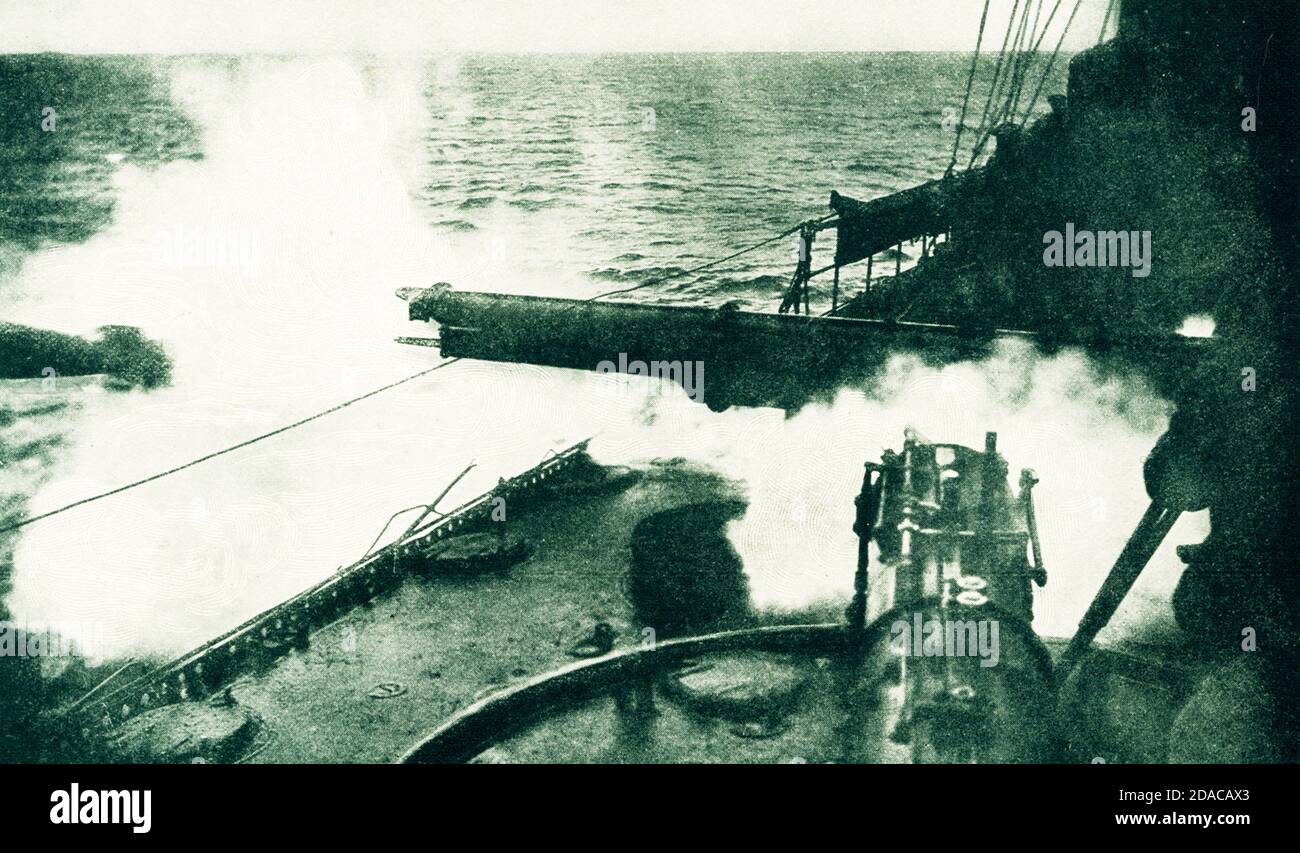 Torpedo being Fired. Firing a torpedo from deck of a german destroyer. The torpedo has just left the tube. Dropping into the water it will continue its course, like a small submarine, straight to its mark. The time period is World War I, but the photo dates to 1916 at the latest. Stock Photohttps://www.alamy.com/image-license-details/?v=1https://www.alamy.com/torpedo-being-fired-firing-a-torpedo-from-deck-of-a-german-destroyer-the-torpedo-has-just-left-the-tube-dropping-into-the-water-it-will-continue-its-course-like-a-small-submarine-straight-to-its-mark-the-time-period-is-world-war-i-but-the-photo-dates-to-1916-at-the-latest-image385046651.html
Torpedo being Fired. Firing a torpedo from deck of a german destroyer. The torpedo has just left the tube. Dropping into the water it will continue its course, like a small submarine, straight to its mark. The time period is World War I, but the photo dates to 1916 at the latest. Stock Photohttps://www.alamy.com/image-license-details/?v=1https://www.alamy.com/torpedo-being-fired-firing-a-torpedo-from-deck-of-a-german-destroyer-the-torpedo-has-just-left-the-tube-dropping-into-the-water-it-will-continue-its-course-like-a-small-submarine-straight-to-its-mark-the-time-period-is-world-war-i-but-the-photo-dates-to-1916-at-the-latest-image385046651.htmlRF2DACAX3–Torpedo being Fired. Firing a torpedo from deck of a german destroyer. The torpedo has just left the tube. Dropping into the water it will continue its course, like a small submarine, straight to its mark. The time period is World War I, but the photo dates to 1916 at the latest.
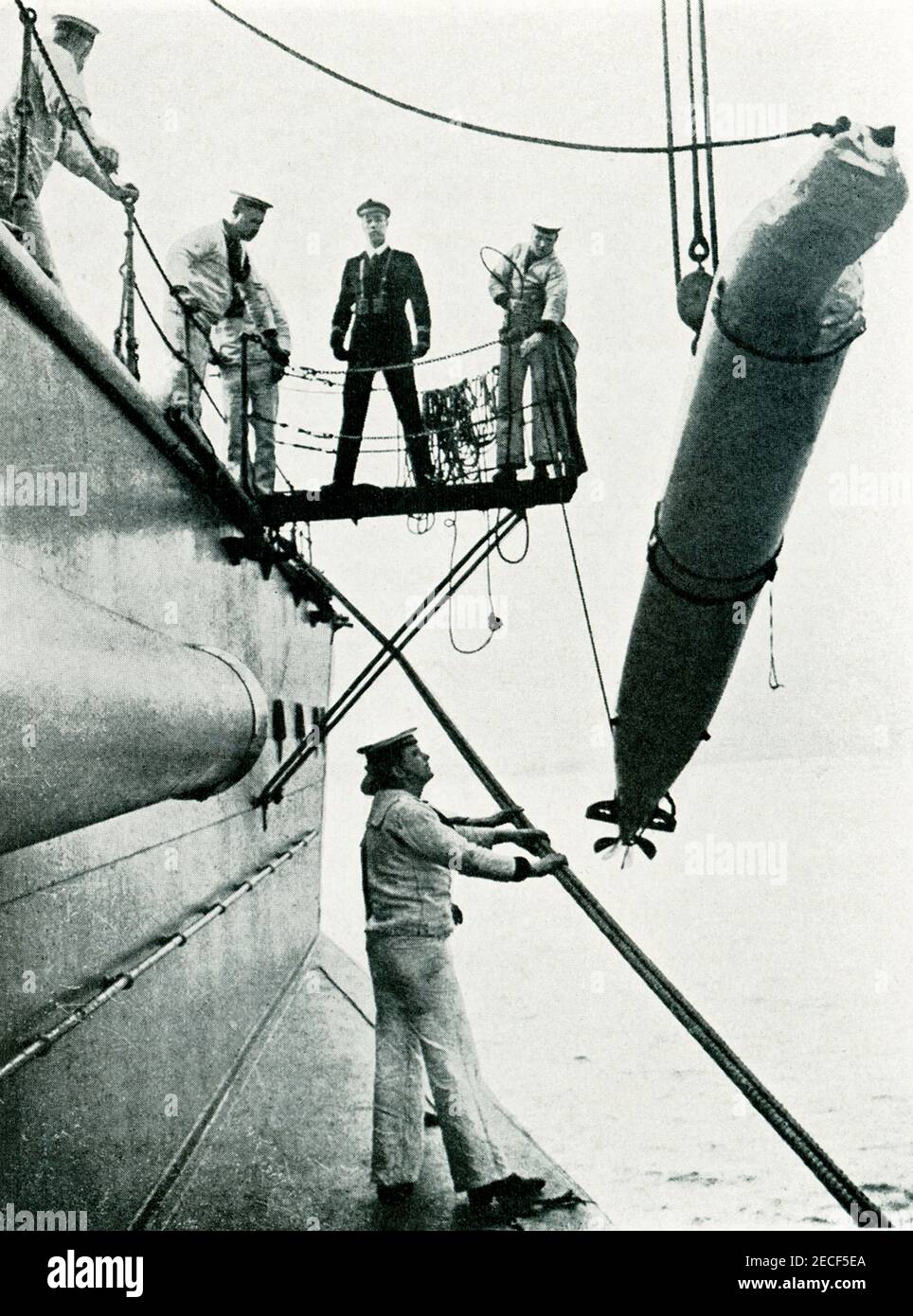 This photo from world war I shows a practice torpedo being hoisted over the side of a British ship. Stock Photohttps://www.alamy.com/image-license-details/?v=1https://www.alamy.com/this-photo-from-world-war-i-shows-a-practice-torpedo-being-hoisted-over-the-side-of-a-british-ship-image403547938.html
This photo from world war I shows a practice torpedo being hoisted over the side of a British ship. Stock Photohttps://www.alamy.com/image-license-details/?v=1https://www.alamy.com/this-photo-from-world-war-i-shows-a-practice-torpedo-being-hoisted-over-the-side-of-a-british-ship-image403547938.htmlRF2ECF5EA–This photo from world war I shows a practice torpedo being hoisted over the side of a British ship.
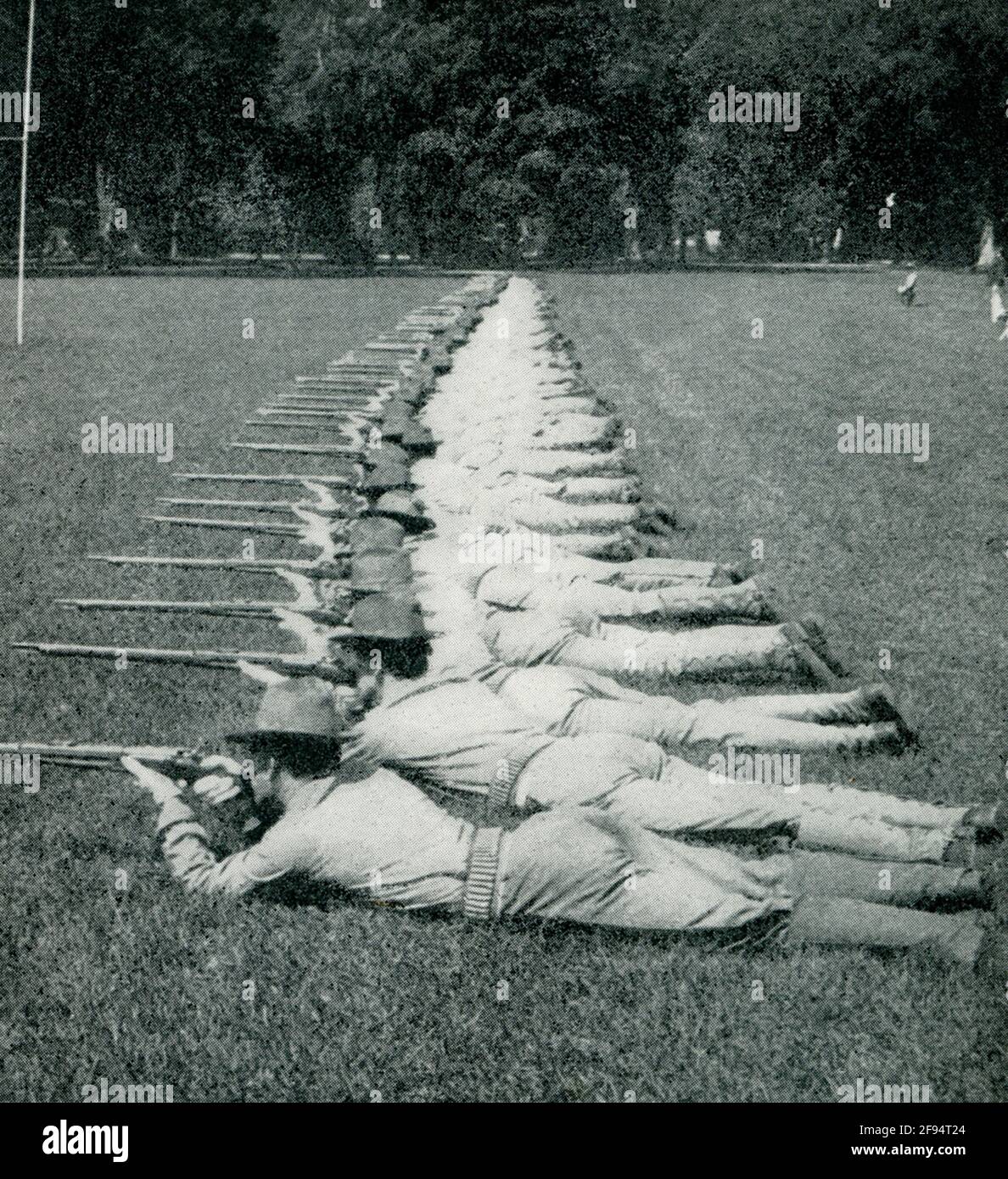 This 1903 photo shows Cadets at West Point Military Academy Skirmish Line. Stock Photohttps://www.alamy.com/image-license-details/?v=1https://www.alamy.com/this-1903-photo-shows-cadets-at-west-point-military-academy-skirmish-line-image418687420.html
This 1903 photo shows Cadets at West Point Military Academy Skirmish Line. Stock Photohttps://www.alamy.com/image-license-details/?v=1https://www.alamy.com/this-1903-photo-shows-cadets-at-west-point-military-academy-skirmish-line-image418687420.htmlRF2F94T24–This 1903 photo shows Cadets at West Point Military Academy Skirmish Line.
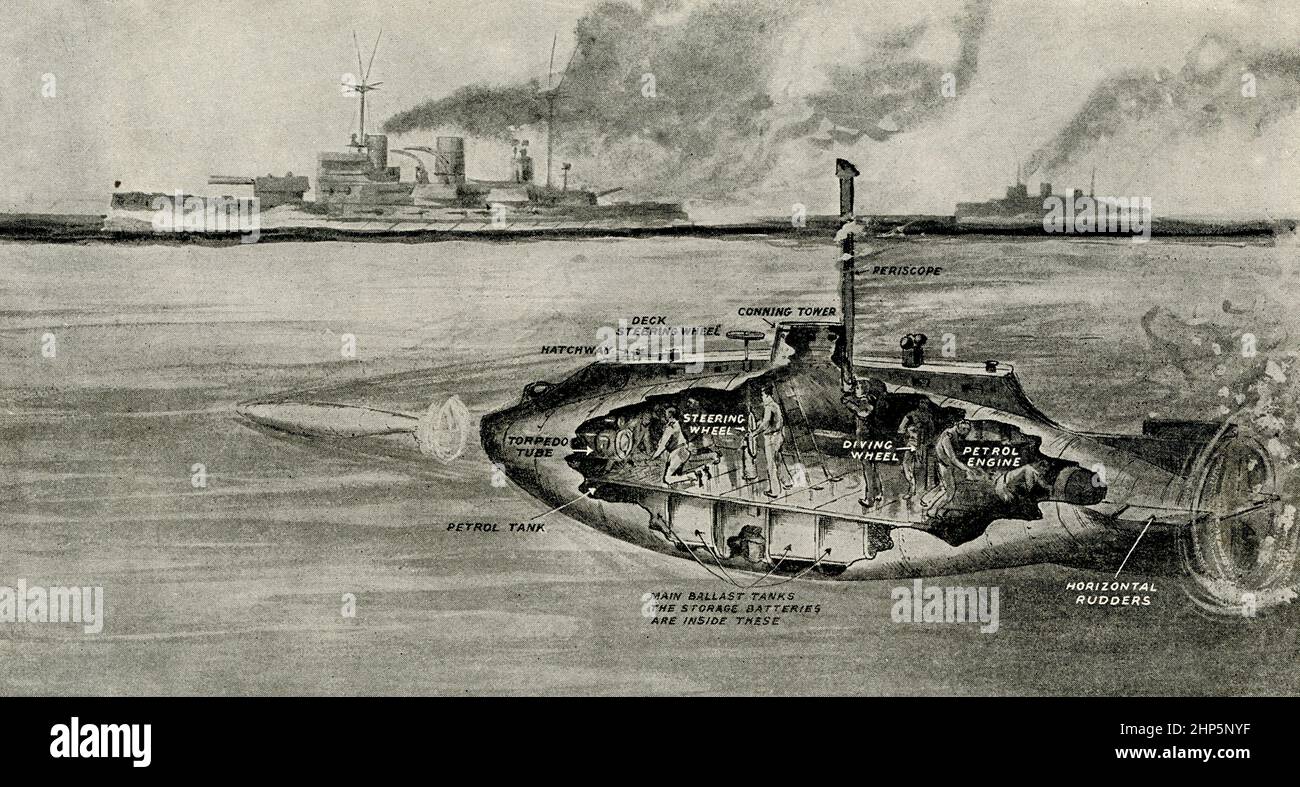 Terrible Enemy that lies hidden in sea. Here we see a submarine in actual war. It is attacking a battleship, and has just struck the great vessel with a torpedo. But the battleship is unable to reply, for the mysterious submarine is hurling its death-dealing missiles beneath the waves, quite out of sight of its opponent. The artist has drawn the submarine in sections to show what the inside is like. When a ship is moving, a torpedo is never fired directly at her. A torpedo travels very slowly compared with a shot from a gun, and because of this, a ship could steam of out of danger if the torp Stock Photohttps://www.alamy.com/image-license-details/?v=1https://www.alamy.com/terrible-enemy-that-lies-hidden-in-sea-here-we-see-a-submarine-in-actual-war-it-is-attacking-a-battleship-and-has-just-struck-the-great-vessel-with-a-torpedo-but-the-battleship-is-unable-to-reply-for-the-mysterious-submarine-is-hurling-its-death-dealing-missiles-beneath-the-waves-quite-out-of-sight-of-its-opponent-the-artist-has-drawn-the-submarine-in-sections-to-show-what-the-inside-is-like-when-a-ship-is-moving-a-torpedo-is-never-fired-directly-at-her-a-torpedo-travels-very-slowly-compared-with-a-shot-from-a-gun-and-because-of-this-a-ship-could-steam-of-out-of-danger-if-the-torp-image461118995.html
Terrible Enemy that lies hidden in sea. Here we see a submarine in actual war. It is attacking a battleship, and has just struck the great vessel with a torpedo. But the battleship is unable to reply, for the mysterious submarine is hurling its death-dealing missiles beneath the waves, quite out of sight of its opponent. The artist has drawn the submarine in sections to show what the inside is like. When a ship is moving, a torpedo is never fired directly at her. A torpedo travels very slowly compared with a shot from a gun, and because of this, a ship could steam of out of danger if the torp Stock Photohttps://www.alamy.com/image-license-details/?v=1https://www.alamy.com/terrible-enemy-that-lies-hidden-in-sea-here-we-see-a-submarine-in-actual-war-it-is-attacking-a-battleship-and-has-just-struck-the-great-vessel-with-a-torpedo-but-the-battleship-is-unable-to-reply-for-the-mysterious-submarine-is-hurling-its-death-dealing-missiles-beneath-the-waves-quite-out-of-sight-of-its-opponent-the-artist-has-drawn-the-submarine-in-sections-to-show-what-the-inside-is-like-when-a-ship-is-moving-a-torpedo-is-never-fired-directly-at-her-a-torpedo-travels-very-slowly-compared-with-a-shot-from-a-gun-and-because-of-this-a-ship-could-steam-of-out-of-danger-if-the-torp-image461118995.htmlRF2HP5NYF–Terrible Enemy that lies hidden in sea. Here we see a submarine in actual war. It is attacking a battleship, and has just struck the great vessel with a torpedo. But the battleship is unable to reply, for the mysterious submarine is hurling its death-dealing missiles beneath the waves, quite out of sight of its opponent. The artist has drawn the submarine in sections to show what the inside is like. When a ship is moving, a torpedo is never fired directly at her. A torpedo travels very slowly compared with a shot from a gun, and because of this, a ship could steam of out of danger if the torp
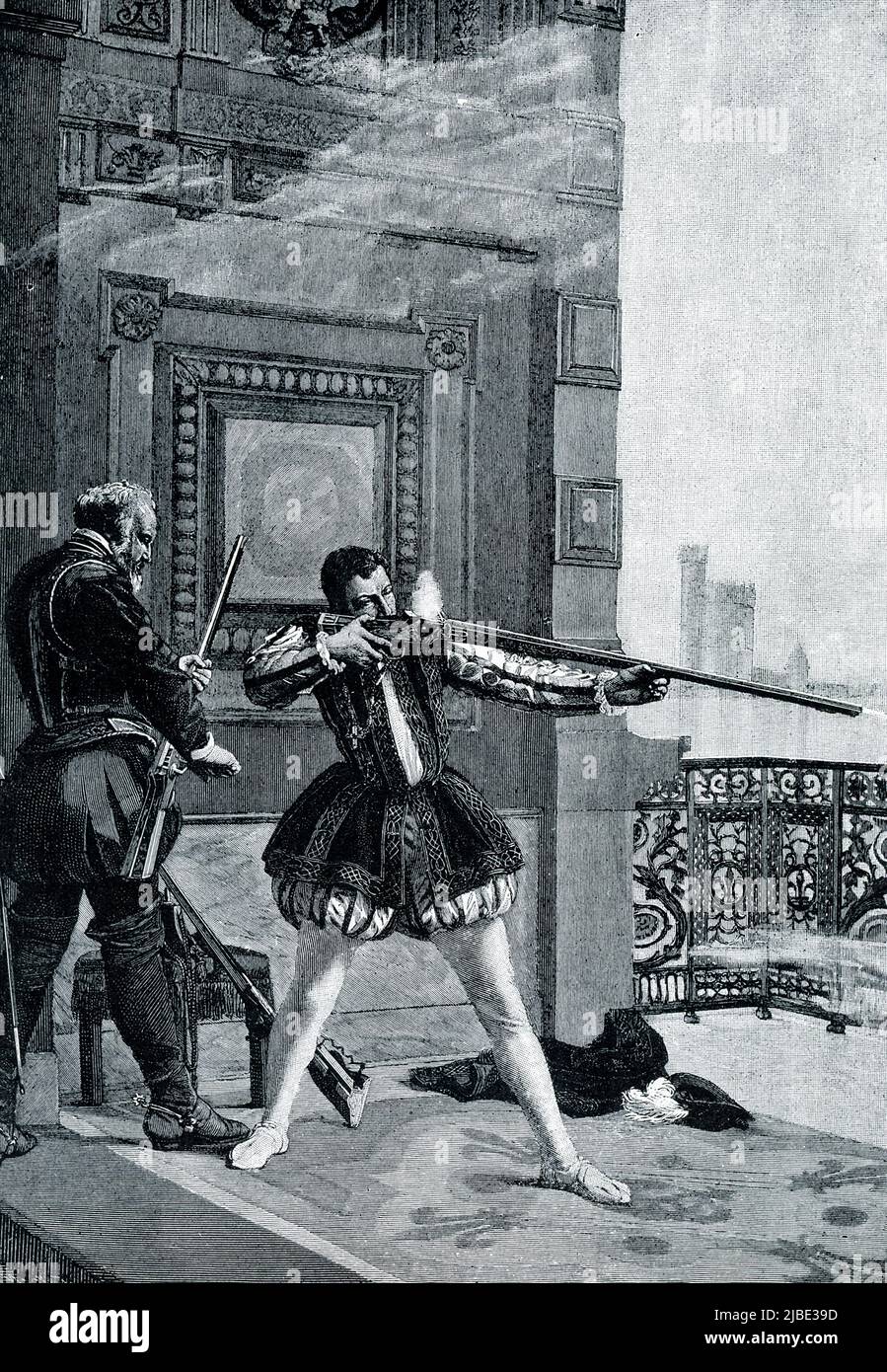 The 1906 caption reads: “CHARLES IX. DURING THE ST. BARTHOLOMEW MASSACRE.—This awful murder of the French Protestants was consented to with reluctance by the weak and sickly young king. Once it had begun, however, he is said to have been seized with a frenzy, and standing before his palace, he grasped a gun, and with an attendant helping him to reload, he fired repeatedly at the fleeing victims.” The St. Bartholomew's Day Massacre happened in 1572 in Paris, France (Charles IX was king). It marked the turning point in the French Wars of Religion (1562-1598) involved the assassinations of the le Stock Photohttps://www.alamy.com/image-license-details/?v=1https://www.alamy.com/the-1906-caption-reads-charles-ix-during-the-st-bartholomew-massacrethis-awful-murder-of-the-french-protestants-was-consented-to-with-reluctance-by-the-weak-and-sickly-young-king-once-it-had-begun-however-he-is-said-to-have-been-seized-with-a-frenzy-and-standing-before-his-palace-he-grasped-a-gun-and-with-an-attendant-helping-him-to-reload-he-fired-repeatedly-at-the-fleeing-victims-the-st-bartholomews-day-massacre-happened-in-1572-in-paris-france-charles-ix-was-king-it-marked-the-turning-point-in-the-french-wars-of-religion-1562-1598-involved-the-assassinations-of-the-le-image471751097.html
The 1906 caption reads: “CHARLES IX. DURING THE ST. BARTHOLOMEW MASSACRE.—This awful murder of the French Protestants was consented to with reluctance by the weak and sickly young king. Once it had begun, however, he is said to have been seized with a frenzy, and standing before his palace, he grasped a gun, and with an attendant helping him to reload, he fired repeatedly at the fleeing victims.” The St. Bartholomew's Day Massacre happened in 1572 in Paris, France (Charles IX was king). It marked the turning point in the French Wars of Religion (1562-1598) involved the assassinations of the le Stock Photohttps://www.alamy.com/image-license-details/?v=1https://www.alamy.com/the-1906-caption-reads-charles-ix-during-the-st-bartholomew-massacrethis-awful-murder-of-the-french-protestants-was-consented-to-with-reluctance-by-the-weak-and-sickly-young-king-once-it-had-begun-however-he-is-said-to-have-been-seized-with-a-frenzy-and-standing-before-his-palace-he-grasped-a-gun-and-with-an-attendant-helping-him-to-reload-he-fired-repeatedly-at-the-fleeing-victims-the-st-bartholomews-day-massacre-happened-in-1572-in-paris-france-charles-ix-was-king-it-marked-the-turning-point-in-the-french-wars-of-religion-1562-1598-involved-the-assassinations-of-the-le-image471751097.htmlRF2JBE39D–The 1906 caption reads: “CHARLES IX. DURING THE ST. BARTHOLOMEW MASSACRE.—This awful murder of the French Protestants was consented to with reluctance by the weak and sickly young king. Once it had begun, however, he is said to have been seized with a frenzy, and standing before his palace, he grasped a gun, and with an attendant helping him to reload, he fired repeatedly at the fleeing victims.” The St. Bartholomew's Day Massacre happened in 1572 in Paris, France (Charles IX was king). It marked the turning point in the French Wars of Religion (1562-1598) involved the assassinations of the le
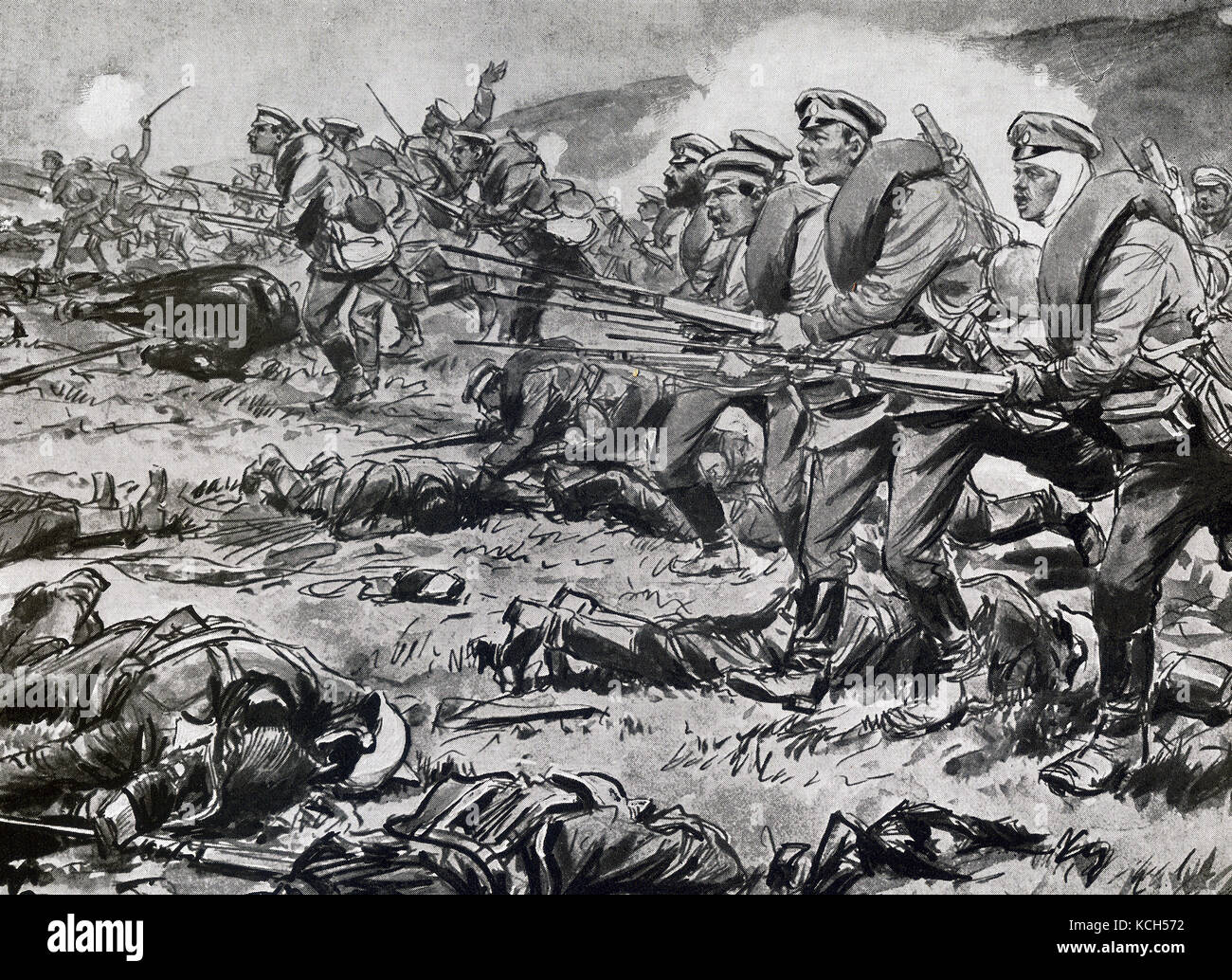 This illustration dates to around 1916. It shows Russian infantry advancing under fire during World War I. Stock Photohttps://www.alamy.com/image-license-details/?v=1https://www.alamy.com/stock-image-this-illustration-dates-to-around-1916-it-shows-russian-infantry-advancing-162646486.html
This illustration dates to around 1916. It shows Russian infantry advancing under fire during World War I. Stock Photohttps://www.alamy.com/image-license-details/?v=1https://www.alamy.com/stock-image-this-illustration-dates-to-around-1916-it-shows-russian-infantry-advancing-162646486.htmlRFKCH572–This illustration dates to around 1916. It shows Russian infantry advancing under fire during World War I.
 This illustration dates to around 1916. It shows Russian infantry advancing under fire during World War I. Stock Photohttps://www.alamy.com/image-license-details/?v=1https://www.alamy.com/stock-image-this-illustration-dates-to-around-1916-it-shows-russian-infantry-advancing-162646488.html
This illustration dates to around 1916. It shows Russian infantry advancing under fire during World War I. Stock Photohttps://www.alamy.com/image-license-details/?v=1https://www.alamy.com/stock-image-this-illustration-dates-to-around-1916-it-shows-russian-infantry-advancing-162646488.htmlRFKCH574–This illustration dates to around 1916. It shows Russian infantry advancing under fire during World War I.
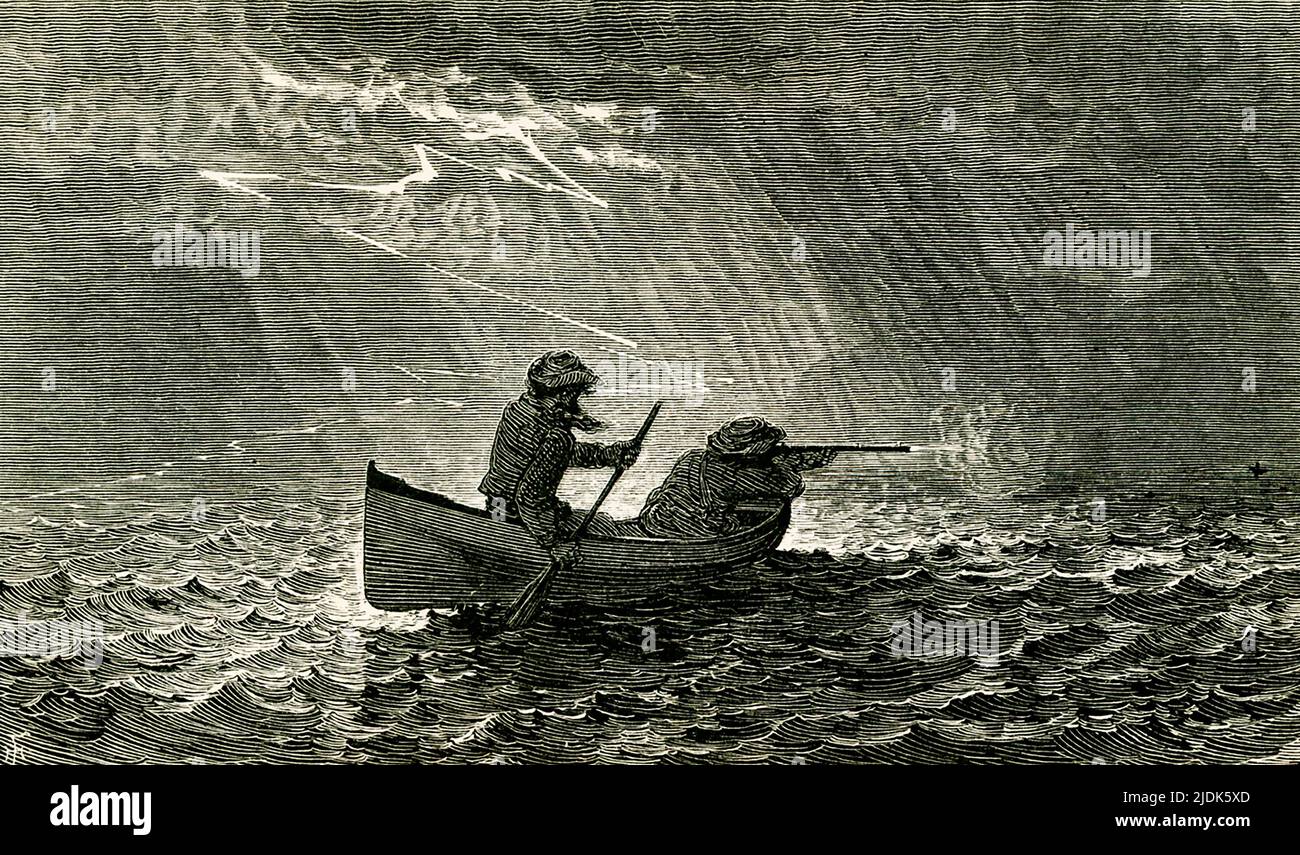 The 1869 caption reads: 'Steady there!' The illustration shows two males in a small boat, one paddling, the other with a gun firing at some animal. The location is the Adirondacks. Stock Photohttps://www.alamy.com/image-license-details/?v=1https://www.alamy.com/the-1869-caption-reads-steady-there!-the-illustration-shows-two-males-in-a-small-boat-one-paddling-the-other-with-a-gun-firing-at-some-animal-the-location-is-the-adirondacks-image473092213.html
The 1869 caption reads: 'Steady there!' The illustration shows two males in a small boat, one paddling, the other with a gun firing at some animal. The location is the Adirondacks. Stock Photohttps://www.alamy.com/image-license-details/?v=1https://www.alamy.com/the-1869-caption-reads-steady-there!-the-illustration-shows-two-males-in-a-small-boat-one-paddling-the-other-with-a-gun-firing-at-some-animal-the-location-is-the-adirondacks-image473092213.htmlRF2JDK5XD–The 1869 caption reads: 'Steady there!' The illustration shows two males in a small boat, one paddling, the other with a gun firing at some animal. The location is the Adirondacks.
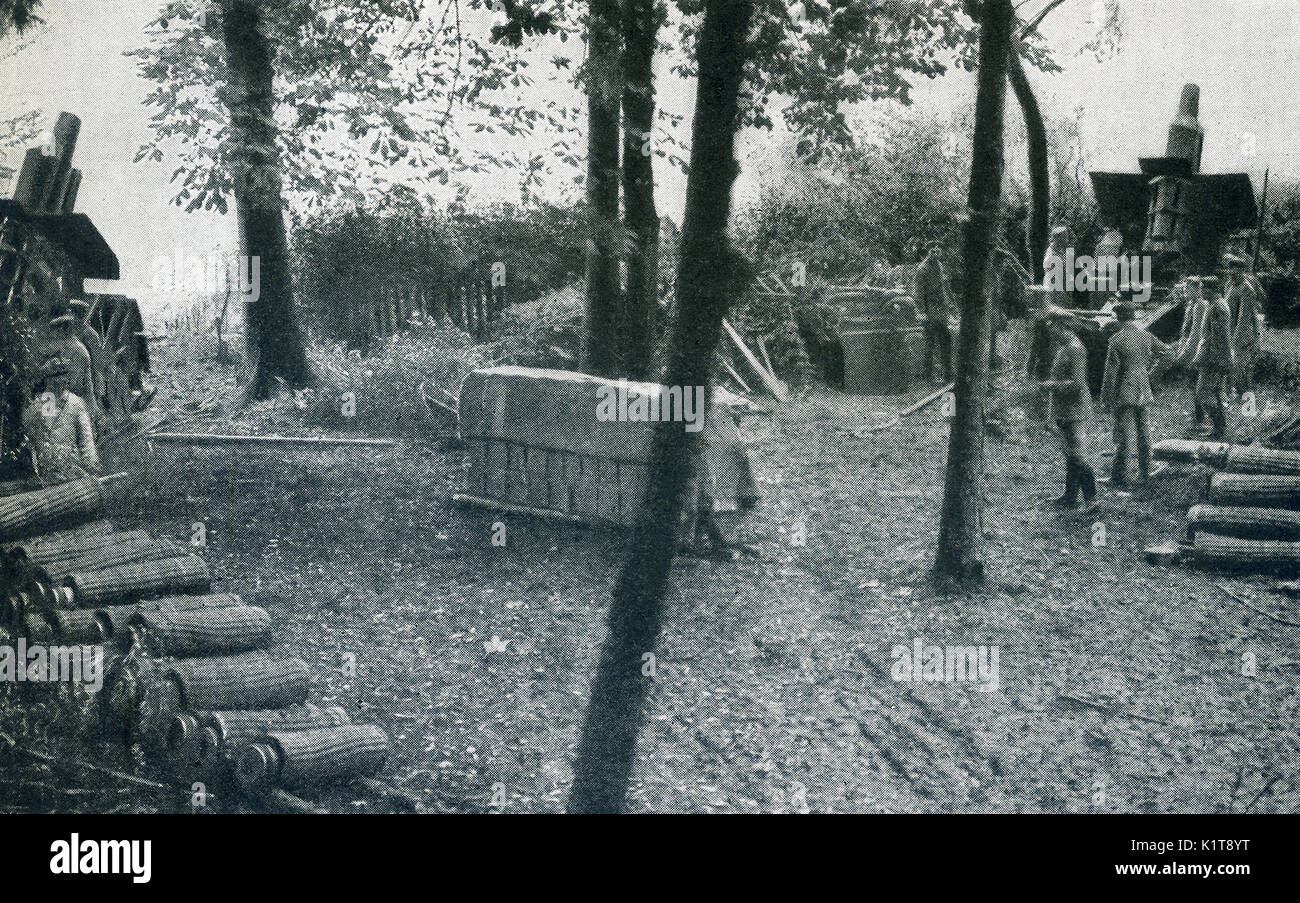 This photo taken in early World War I has the caption: Siege guns in action under cover of a forest. This picture shows two heavy German mortars firing on the French. The guns are levated at a high angle so that the heavy projecties fall almost vertically on the enemy's forts. Stock Photohttps://www.alamy.com/image-license-details/?v=1https://www.alamy.com/this-photo-taken-in-early-world-war-i-has-the-caption-siege-guns-in-image156041868.html
This photo taken in early World War I has the caption: Siege guns in action under cover of a forest. This picture shows two heavy German mortars firing on the French. The guns are levated at a high angle so that the heavy projecties fall almost vertically on the enemy's forts. Stock Photohttps://www.alamy.com/image-license-details/?v=1https://www.alamy.com/this-photo-taken-in-early-world-war-i-has-the-caption-siege-guns-in-image156041868.htmlRFK1T8YT–This photo taken in early World War I has the caption: Siege guns in action under cover of a forest. This picture shows two heavy German mortars firing on the French. The guns are levated at a high angle so that the heavy projecties fall almost vertically on the enemy's forts.
 This photo taken in early World War I has the caption: Siege guns in action under cover of a forest. This picture shows two heavy German mortars firing on the French. The guns are levated at a high angle so that the heavy projecties fall almost vertically on the enemy's forts. Stock Photohttps://www.alamy.com/image-license-details/?v=1https://www.alamy.com/this-photo-taken-in-early-world-war-i-has-the-caption-siege-guns-in-image156041874.html
This photo taken in early World War I has the caption: Siege guns in action under cover of a forest. This picture shows two heavy German mortars firing on the French. The guns are levated at a high angle so that the heavy projecties fall almost vertically on the enemy's forts. Stock Photohttps://www.alamy.com/image-license-details/?v=1https://www.alamy.com/this-photo-taken-in-early-world-war-i-has-the-caption-siege-guns-in-image156041874.htmlRFK1T902–This photo taken in early World War I has the caption: Siege guns in action under cover of a forest. This picture shows two heavy German mortars firing on the French. The guns are levated at a high angle so that the heavy projecties fall almost vertically on the enemy's forts.
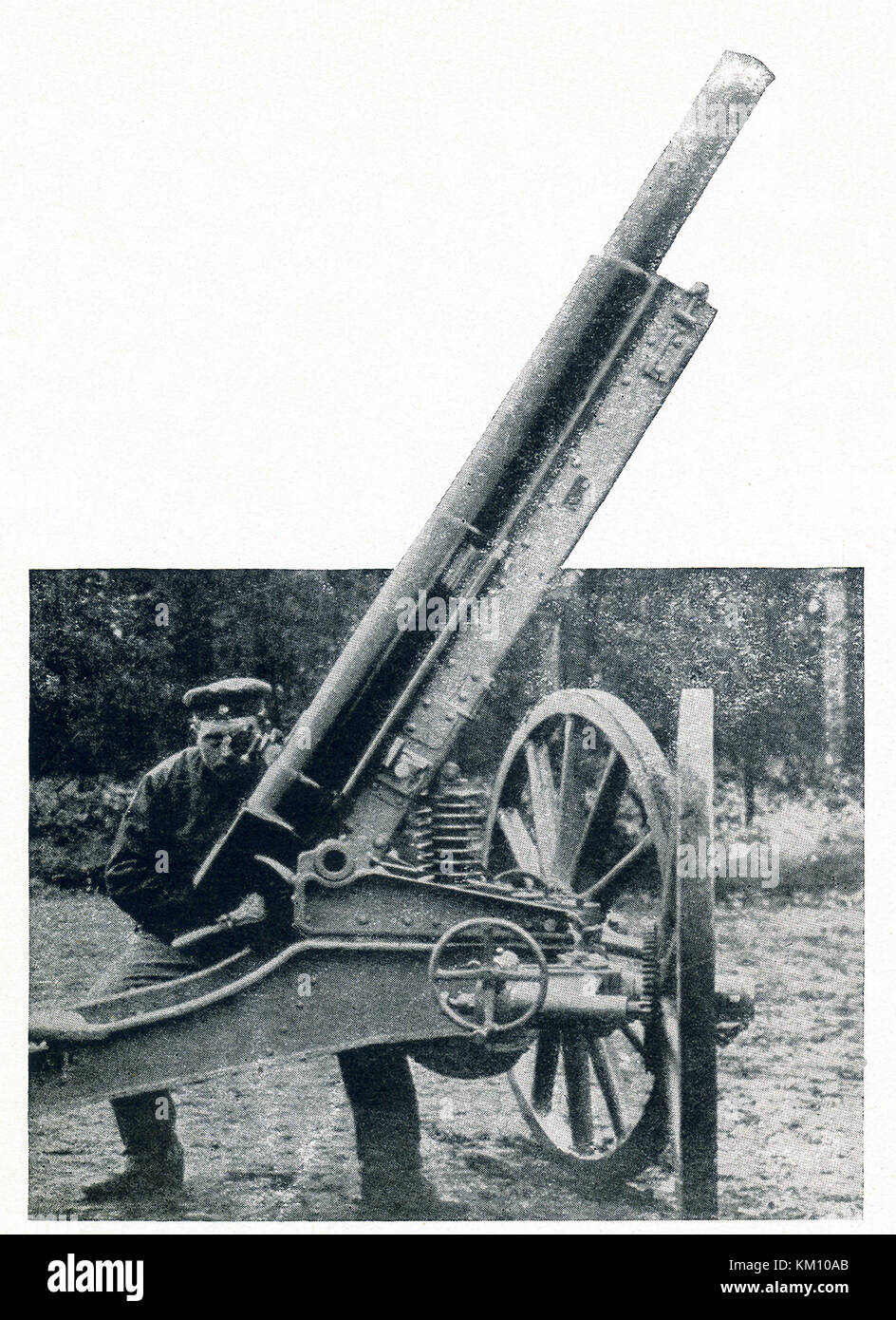 The caption that accompanied this phot that dates to around 1916, read: The latest product of the Krupps work is a specially designed gun for defense against the enemy of the clouds. The Krupps gun is a family of artillery pieces that several armies throughout the world have used starting with the 1800s. Krupp produced a 75 mm quick-firing gun that was used in World War I. Stock Photohttps://www.alamy.com/image-license-details/?v=1https://www.alamy.com/stock-image-the-caption-that-accompanied-this-phot-that-dates-to-around-1916-read-167208675.html
The caption that accompanied this phot that dates to around 1916, read: The latest product of the Krupps work is a specially designed gun for defense against the enemy of the clouds. The Krupps gun is a family of artillery pieces that several armies throughout the world have used starting with the 1800s. Krupp produced a 75 mm quick-firing gun that was used in World War I. Stock Photohttps://www.alamy.com/image-license-details/?v=1https://www.alamy.com/stock-image-the-caption-that-accompanied-this-phot-that-dates-to-around-1916-read-167208675.htmlRFKM10AB–The caption that accompanied this phot that dates to around 1916, read: The latest product of the Krupps work is a specially designed gun for defense against the enemy of the clouds. The Krupps gun is a family of artillery pieces that several armies throughout the world have used starting with the 1800s. Krupp produced a 75 mm quick-firing gun that was used in World War I.
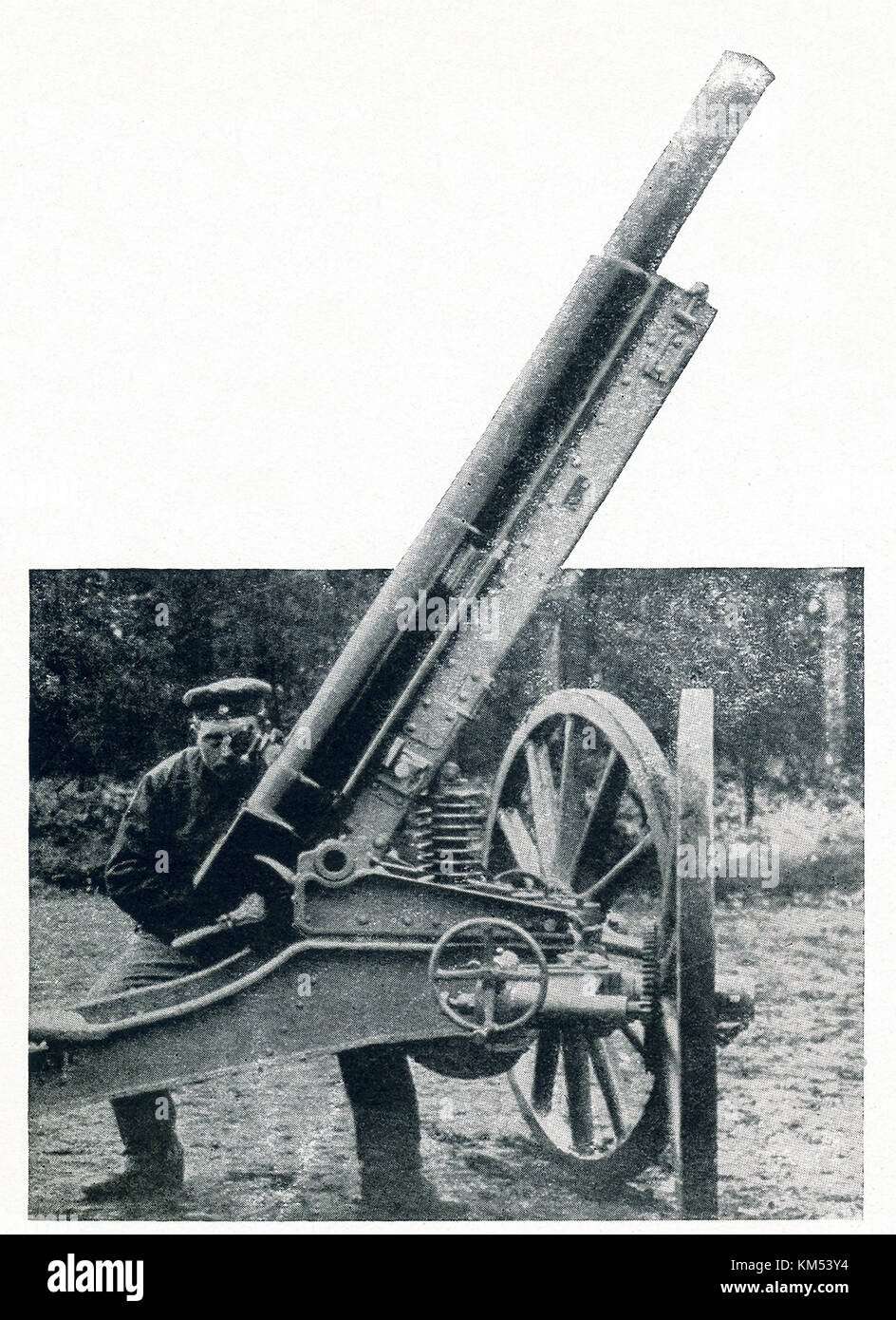 The caption that accompanied this phot that dates to around 1916, read: The latest product of the Krupps work is a specially designed gun for defense against the enemy of the clouds. The Krupps gun is a family of artillery pieces that several armies throughout the world have used starting with the 1800s. Krupp produced a 75 mm quick-firing gun that was used in World War I. Stock Photohttps://www.alamy.com/image-license-details/?v=1https://www.alamy.com/stock-image-the-caption-that-accompanied-this-phot-that-dates-to-around-1916-read-167299304.html
The caption that accompanied this phot that dates to around 1916, read: The latest product of the Krupps work is a specially designed gun for defense against the enemy of the clouds. The Krupps gun is a family of artillery pieces that several armies throughout the world have used starting with the 1800s. Krupp produced a 75 mm quick-firing gun that was used in World War I. Stock Photohttps://www.alamy.com/image-license-details/?v=1https://www.alamy.com/stock-image-the-caption-that-accompanied-this-phot-that-dates-to-around-1916-read-167299304.htmlRFKM53Y4–The caption that accompanied this phot that dates to around 1916, read: The latest product of the Krupps work is a specially designed gun for defense against the enemy of the clouds. The Krupps gun is a family of artillery pieces that several armies throughout the world have used starting with the 1800s. Krupp produced a 75 mm quick-firing gun that was used in World War I.
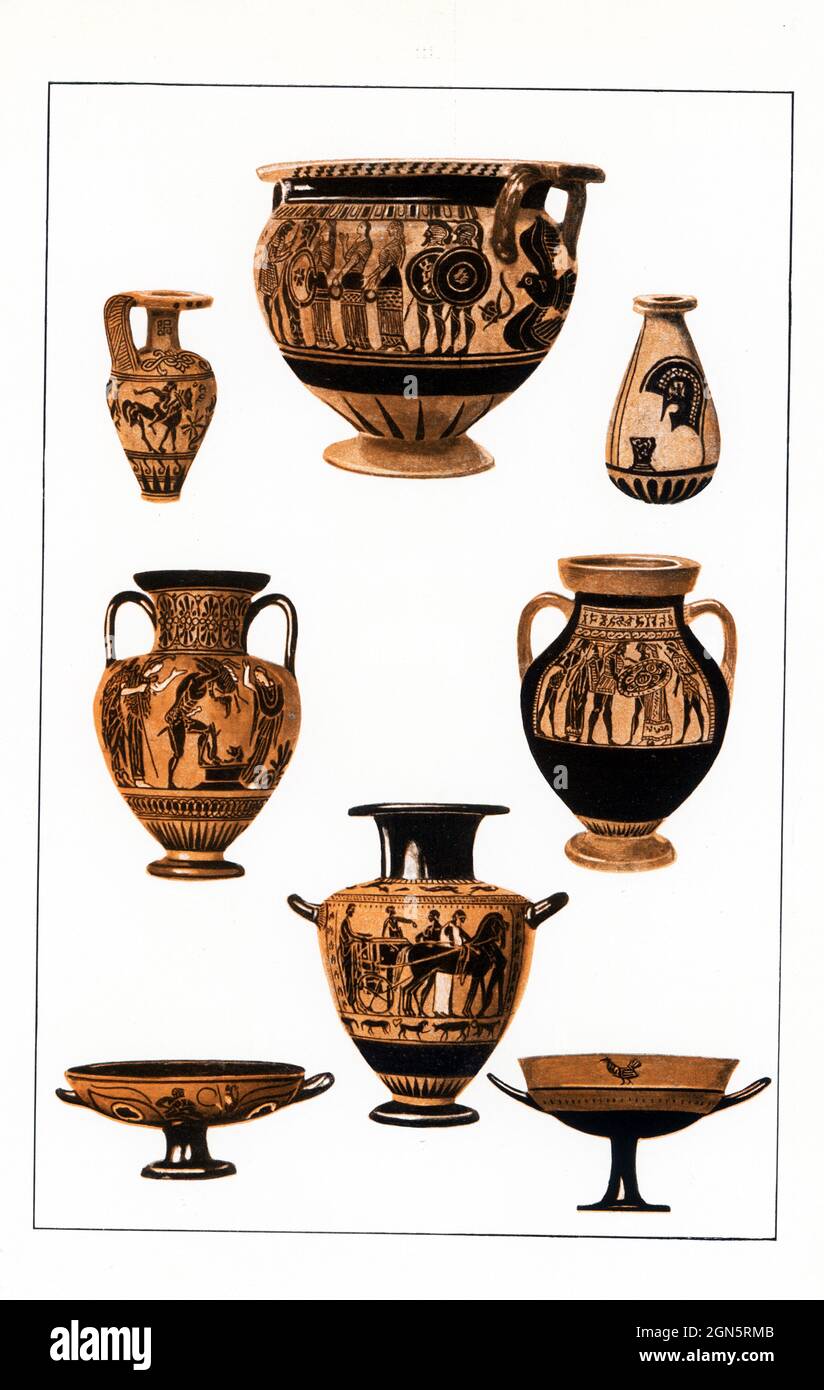 Shown here are vases dating from end of the 7th century (600s BC) and they reflect the Attic and Corinthian style known as black-figured vases. The black-figure technique of vase painting was invented in the city of Corinth around 700 B.C. It was around this time that Corinthian vase painters began adorning their vessels with animal friezes and occasional mythological scenes and they developed this new style of painting to depict these motifs. As the vases were being made, a liquid clay called slip was applied to patch up weak areas or hold pieces together. The slip turned black during firing Stock Photohttps://www.alamy.com/image-license-details/?v=1https://www.alamy.com/shown-here-are-vases-dating-from-end-of-the-7th-century-600s-bc-and-they-reflect-the-attic-and-corinthian-style-known-as-black-figured-vases-the-black-figure-technique-of-vase-painting-wasinvented-in-the-city-of-corinth-around-700-bcit-was-around-this-time-that-corinthian-vase-painters-began-adorning-their-vessels-with-animal-friezes-and-occasional-mythological-scenes-and-they-developed-this-new-style-of-painting-to-depict-these-motifs-as-the-vases-were-being-made-aliquid-clay-called-slipwas-applied-to-patch-up-weak-areas-or-hold-pieces-together-the-slip-turned-black-during-firing-image443295339.html
Shown here are vases dating from end of the 7th century (600s BC) and they reflect the Attic and Corinthian style known as black-figured vases. The black-figure technique of vase painting was invented in the city of Corinth around 700 B.C. It was around this time that Corinthian vase painters began adorning their vessels with animal friezes and occasional mythological scenes and they developed this new style of painting to depict these motifs. As the vases were being made, a liquid clay called slip was applied to patch up weak areas or hold pieces together. The slip turned black during firing Stock Photohttps://www.alamy.com/image-license-details/?v=1https://www.alamy.com/shown-here-are-vases-dating-from-end-of-the-7th-century-600s-bc-and-they-reflect-the-attic-and-corinthian-style-known-as-black-figured-vases-the-black-figure-technique-of-vase-painting-wasinvented-in-the-city-of-corinth-around-700-bcit-was-around-this-time-that-corinthian-vase-painters-began-adorning-their-vessels-with-animal-friezes-and-occasional-mythological-scenes-and-they-developed-this-new-style-of-painting-to-depict-these-motifs-as-the-vases-were-being-made-aliquid-clay-called-slipwas-applied-to-patch-up-weak-areas-or-hold-pieces-together-the-slip-turned-black-during-firing-image443295339.htmlRF2GN5RMB–Shown here are vases dating from end of the 7th century (600s BC) and they reflect the Attic and Corinthian style known as black-figured vases. The black-figure technique of vase painting was invented in the city of Corinth around 700 B.C. It was around this time that Corinthian vase painters began adorning their vessels with animal friezes and occasional mythological scenes and they developed this new style of painting to depict these motifs. As the vases were being made, a liquid clay called slip was applied to patch up weak areas or hold pieces together. The slip turned black during firing
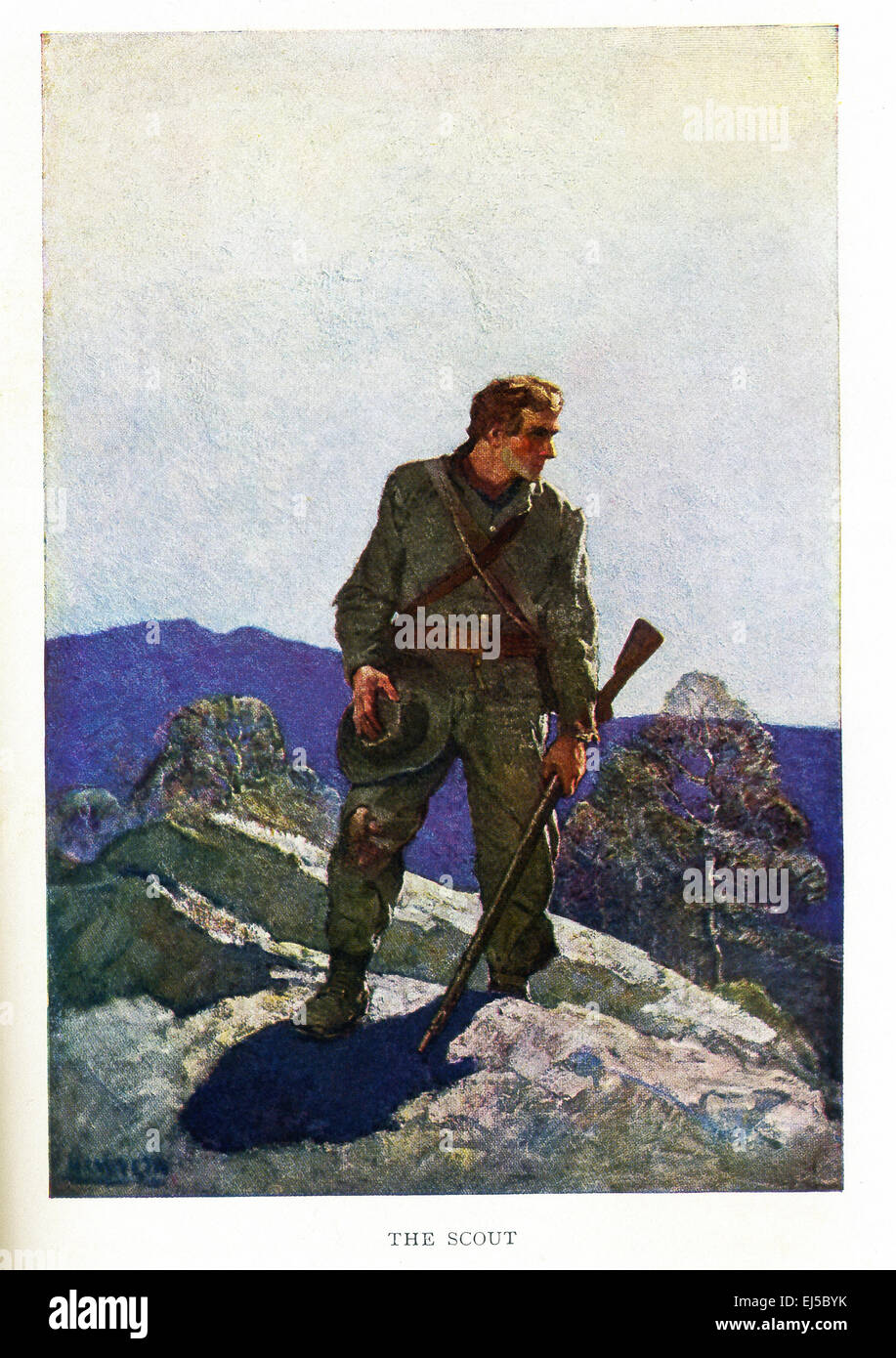 This illustration titled The Scout is from Mary Johnston's 1912 novel titled Cease Firing, which was illustrated by American artist N.C. Wyeth. This illustration served also as the front book cover. Scouts were used to check out the terrain, check enemy positions and the like ahead of the army's advance. Stock Photohttps://www.alamy.com/image-license-details/?v=1https://www.alamy.com/stock-photo-this-illustration-titled-the-scout-is-from-mary-johnstons-1912-novel-80024439.html
This illustration titled The Scout is from Mary Johnston's 1912 novel titled Cease Firing, which was illustrated by American artist N.C. Wyeth. This illustration served also as the front book cover. Scouts were used to check out the terrain, check enemy positions and the like ahead of the army's advance. Stock Photohttps://www.alamy.com/image-license-details/?v=1https://www.alamy.com/stock-photo-this-illustration-titled-the-scout-is-from-mary-johnstons-1912-novel-80024439.htmlRFEJ5BYK–This illustration titled The Scout is from Mary Johnston's 1912 novel titled Cease Firing, which was illustrated by American artist N.C. Wyeth. This illustration served also as the front book cover. Scouts were used to check out the terrain, check enemy positions and the like ahead of the army's advance.
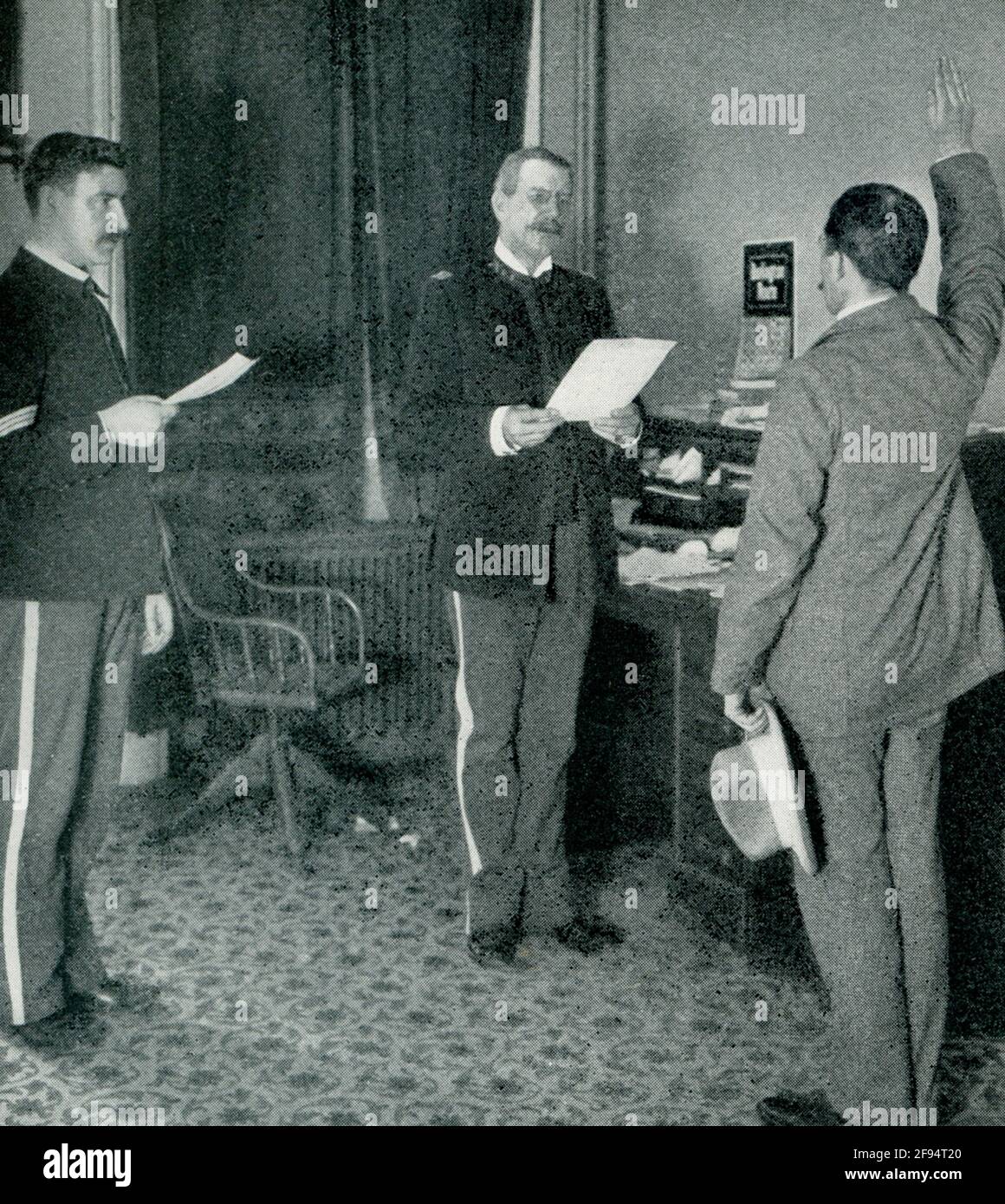 This 1903 photo shows an Army recruiting officer administering oath. Stock Photohttps://www.alamy.com/image-license-details/?v=1https://www.alamy.com/this-1903-photo-shows-an-army-recruiting-officer-administering-oath-image418687416.html
This 1903 photo shows an Army recruiting officer administering oath. Stock Photohttps://www.alamy.com/image-license-details/?v=1https://www.alamy.com/this-1903-photo-shows-an-army-recruiting-officer-administering-oath-image418687416.htmlRF2F94T20–This 1903 photo shows an Army recruiting officer administering oath.
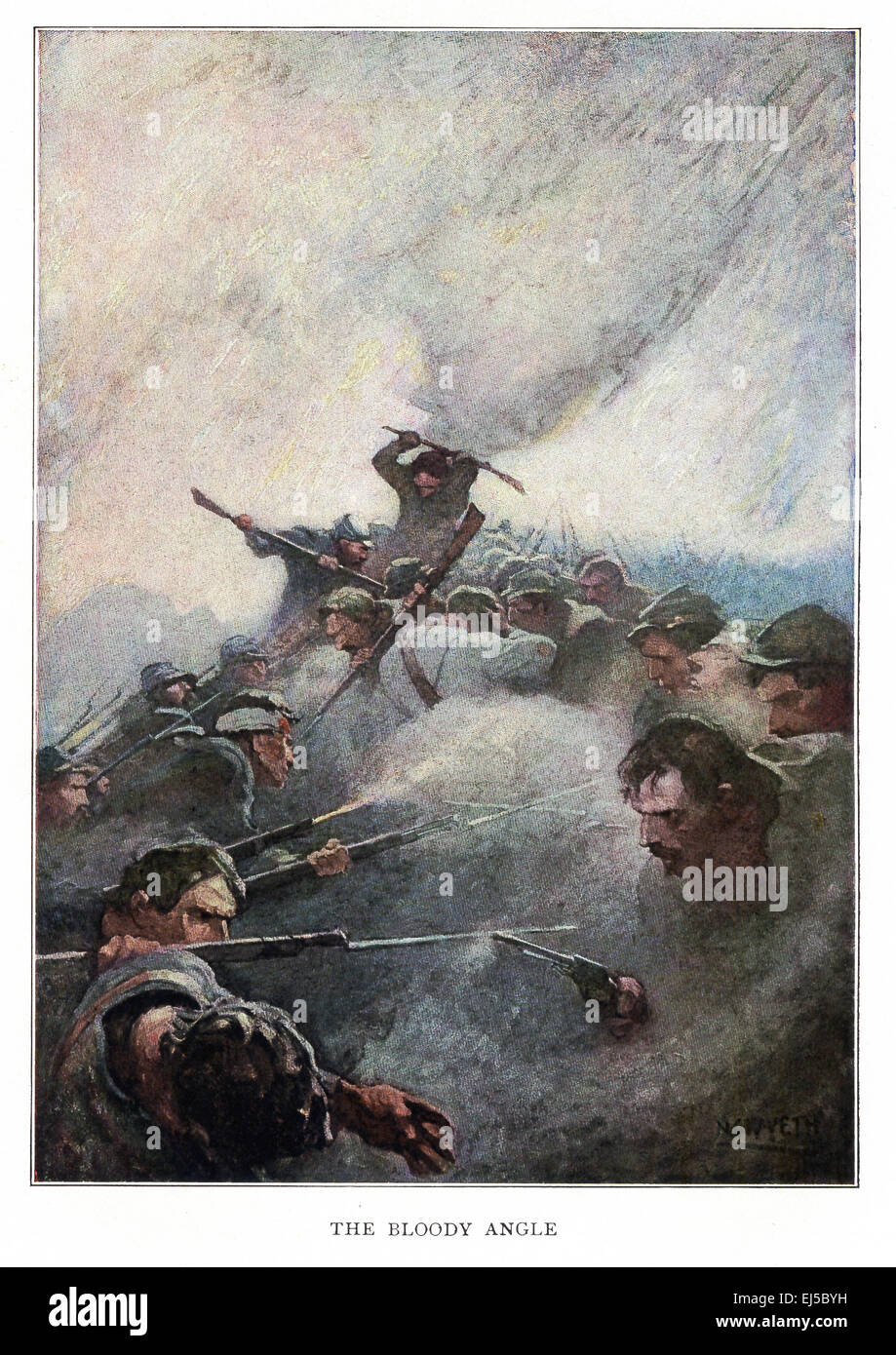 This illustration titled The Bloody Angle is from Mary Johnston's 1912 novel titled Cease Firing, which was illustrated by American artist N.C. Wyeth. Bloody Angle was part of the Battle of Spotsylvania Court House fought in Virginia in May 1864, during the American Civil War. Ulysses Grant tried to break through the Confederate line, but was unable - there was no winner and the casualties were very high. Stock Photohttps://www.alamy.com/image-license-details/?v=1https://www.alamy.com/stock-photo-this-illustration-titled-the-bloody-angle-is-from-mary-johnstons-1912-80024437.html
This illustration titled The Bloody Angle is from Mary Johnston's 1912 novel titled Cease Firing, which was illustrated by American artist N.C. Wyeth. Bloody Angle was part of the Battle of Spotsylvania Court House fought in Virginia in May 1864, during the American Civil War. Ulysses Grant tried to break through the Confederate line, but was unable - there was no winner and the casualties were very high. Stock Photohttps://www.alamy.com/image-license-details/?v=1https://www.alamy.com/stock-photo-this-illustration-titled-the-bloody-angle-is-from-mary-johnstons-1912-80024437.htmlRFEJ5BYH–This illustration titled The Bloody Angle is from Mary Johnston's 1912 novel titled Cease Firing, which was illustrated by American artist N.C. Wyeth. Bloody Angle was part of the Battle of Spotsylvania Court House fought in Virginia in May 1864, during the American Civil War. Ulysses Grant tried to break through the Confederate line, but was unable - there was no winner and the casualties were very high.
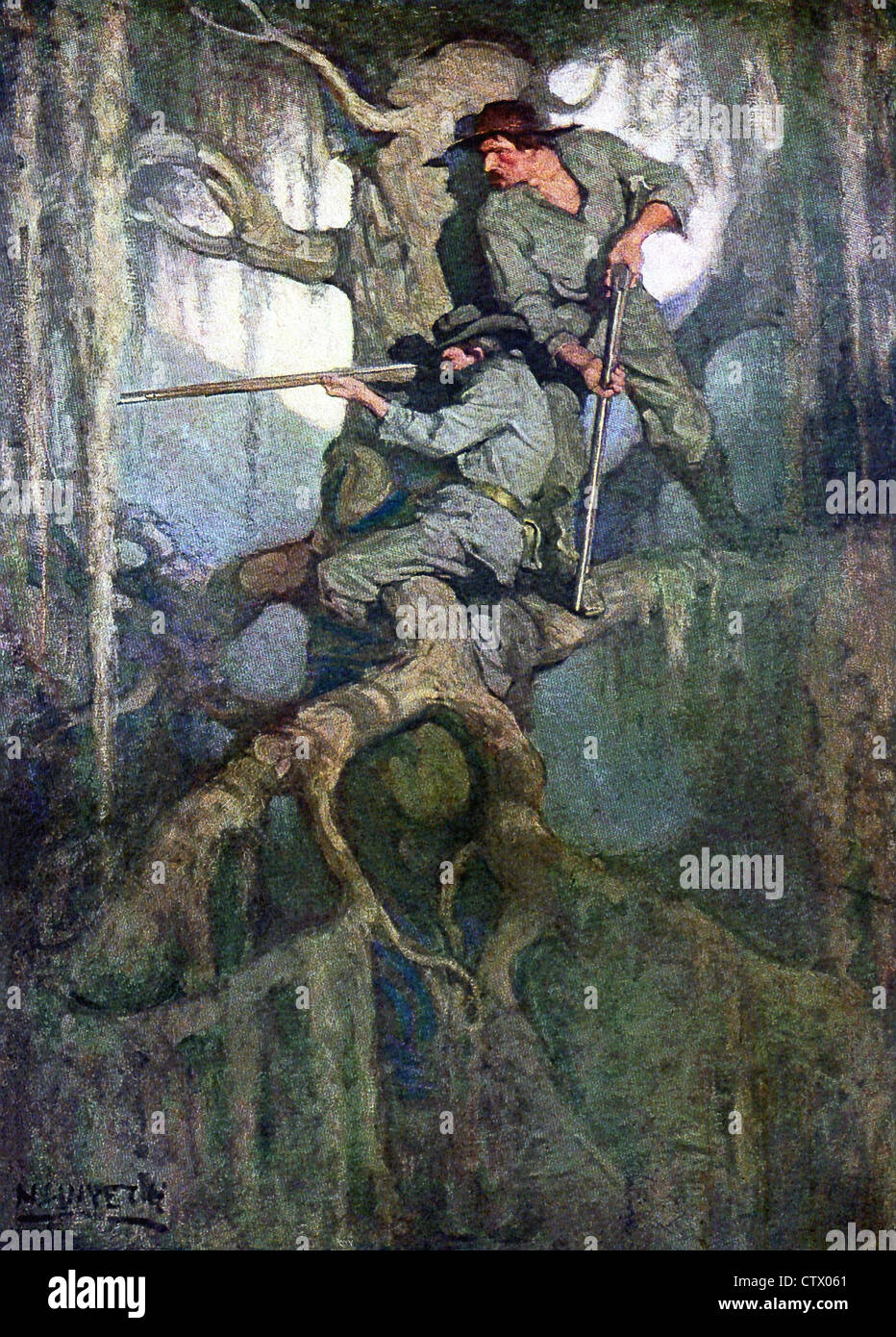 This illustration, titled Sharpshooters, is by N.C. Wyeth and appeared in Cease Firing, a novel by Mary Johnston. Stock Photohttps://www.alamy.com/image-license-details/?v=1https://www.alamy.com/stock-photo-this-illustration-titled-sharpshooters-is-by-nc-wyeth-and-appeared-49743401.html
This illustration, titled Sharpshooters, is by N.C. Wyeth and appeared in Cease Firing, a novel by Mary Johnston. Stock Photohttps://www.alamy.com/image-license-details/?v=1https://www.alamy.com/stock-photo-this-illustration-titled-sharpshooters-is-by-nc-wyeth-and-appeared-49743401.htmlRFCTX061–This illustration, titled Sharpshooters, is by N.C. Wyeth and appeared in Cease Firing, a novel by Mary Johnston.
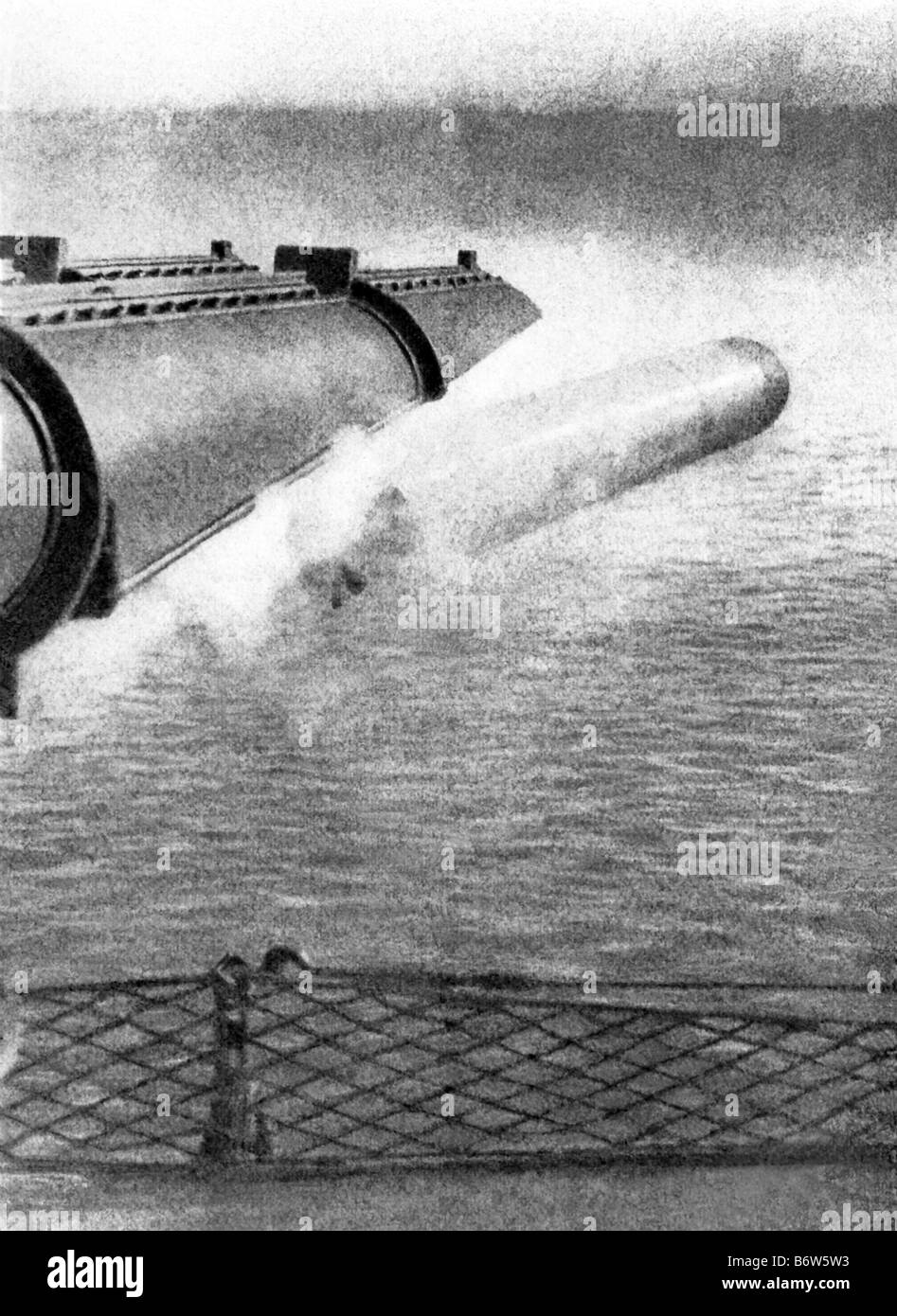 Torpedo in Motion Stock Photohttps://www.alamy.com/image-license-details/?v=1https://www.alamy.com/stock-photo-torpedo-in-motion-21451727.html
Torpedo in Motion Stock Photohttps://www.alamy.com/image-license-details/?v=1https://www.alamy.com/stock-photo-torpedo-in-motion-21451727.htmlRFB6W5W3–Torpedo in Motion
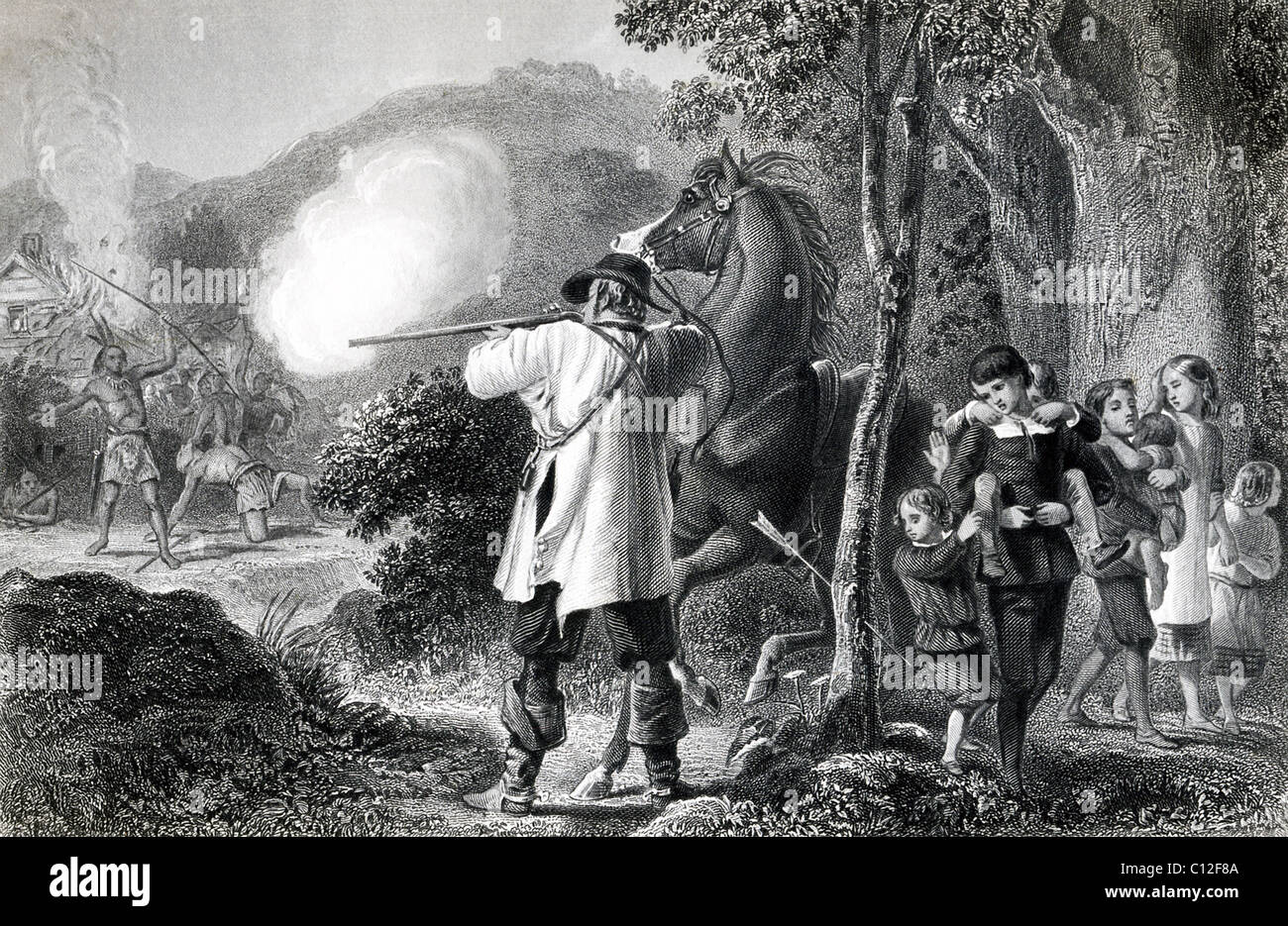 On March 15, 1697, Mr. Dunstan took a rifle and kept firing to protect the seven children with whom he managed to escape. Stock Photohttps://www.alamy.com/image-license-details/?v=1https://www.alamy.com/stock-photo-on-march-15-1697-mr-dunstan-took-a-rifle-and-kept-firing-to-protect-35091290.html
On March 15, 1697, Mr. Dunstan took a rifle and kept firing to protect the seven children with whom he managed to escape. Stock Photohttps://www.alamy.com/image-license-details/?v=1https://www.alamy.com/stock-photo-on-march-15-1697-mr-dunstan-took-a-rifle-and-kept-firing-to-protect-35091290.htmlRFC12F8A–On March 15, 1697, Mr. Dunstan took a rifle and kept firing to protect the seven children with whom he managed to escape.
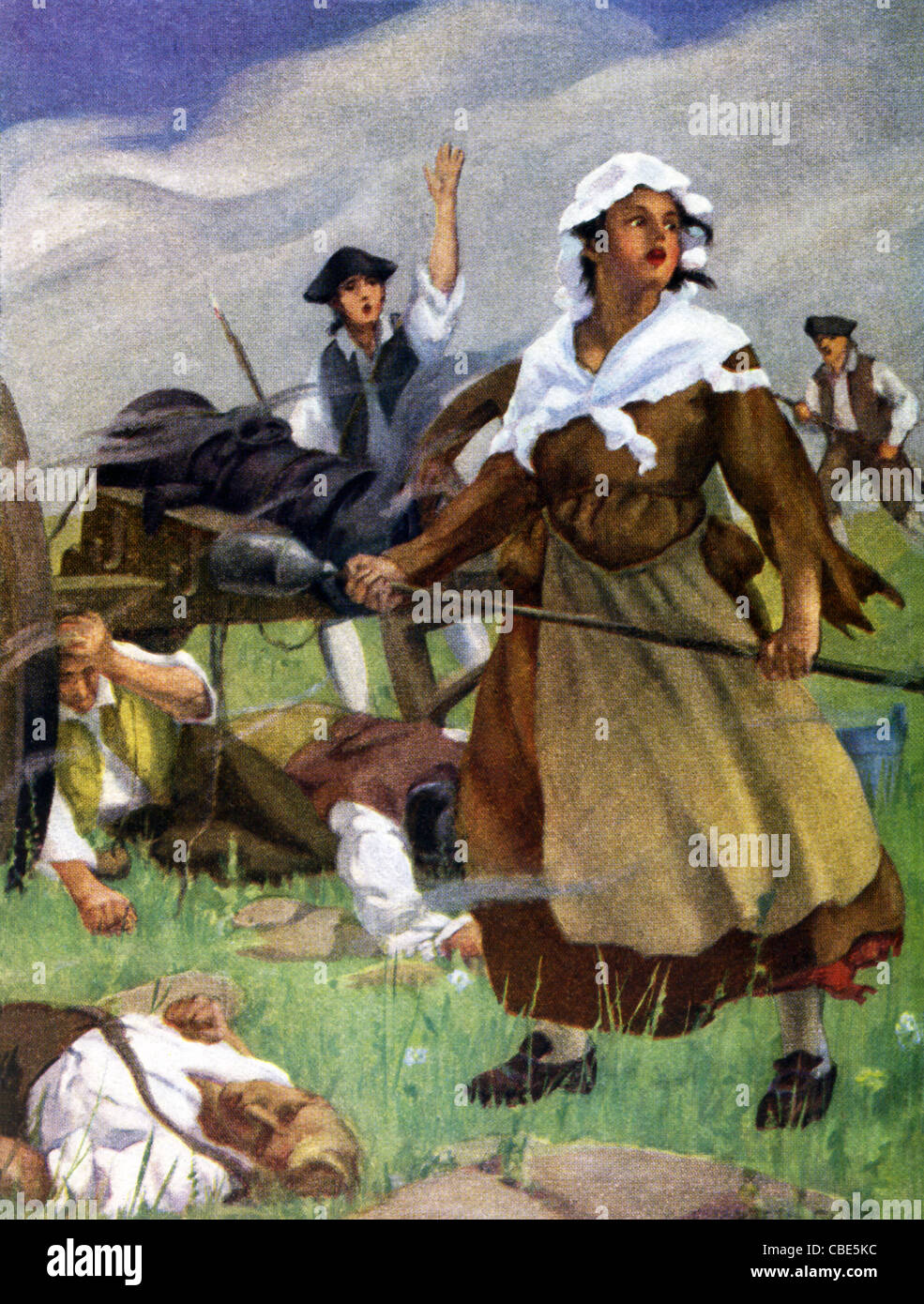 A woman nicknamed Molly Pitcher was said to have fought for the colonists during the American Revolution. Stock Photohttps://www.alamy.com/image-license-details/?v=1https://www.alamy.com/stock-photo-a-woman-nicknamed-molly-pitcher-was-said-to-have-fought-for-the-colonists-41493744.html
A woman nicknamed Molly Pitcher was said to have fought for the colonists during the American Revolution. Stock Photohttps://www.alamy.com/image-license-details/?v=1https://www.alamy.com/stock-photo-a-woman-nicknamed-molly-pitcher-was-said-to-have-fought-for-the-colonists-41493744.htmlRFCBE5KC–A woman nicknamed Molly Pitcher was said to have fought for the colonists during the American Revolution.